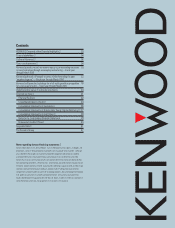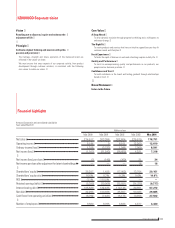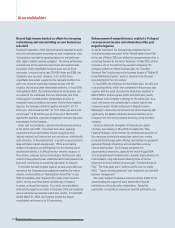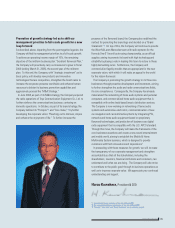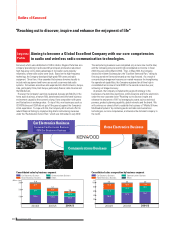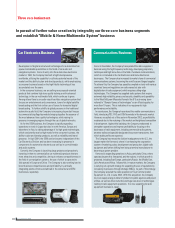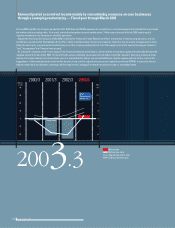Kenwood 2004 Annual Report Download - page 11
Download and view the complete annual report
Please find page 11 of the 2004 Kenwood annual report below. You can navigate through the pages in the report by either clicking on the pages listed below, or by using the keyword search tool below to find specific information within the annual report.
Elimination of money-losing businesses through
"business restructuring"
In the Home Electronics Business, after reassessing product models and sales
territories, the Company revised its marketing strategy and decided to sell home
theater systems, pure audio equipment and portable radio devices mainly in the
three major markets, Japan, North America and Europe. As for the
Communications Business, the Company in November 2002 pulled out of the
development and production of cellular telephones, while focusing on the radio
equipment business, with the emphasis on: commercial radio systems, amateur
radios and specially-designated small power transceivers.
Through these moves, the Company established a management framework that
centers on the three core businesses, car electronics, home electronics and radio
communication equipment, with "audio" and "radio communications," which are
the core competence the Company has been engaged in for over five decades
since its foundation.
Reduction in consolidated fixed and production costs
through "cost restructuring"
Of the nine production bases worldwide, the Company sold plants in Mexico and
Huizhou (China), closed a factory in Hungary as well as scaled down its
operations at plants in Yamagata (Japan), France and Singapore, through
"business restructuring" moves that enabled fixed and production costs to be
reduced.
In an effort to overhaul the sales structure, the Company succeeded in reducing
sales, general and administrative expenses at home by consolidating sales
offices and introducing a sales agent system. Outside Japan, it consolidated
sales firms in the Americas, while setting up regional supervisory offices in
Europe and Asia.
Furthermore, to optimize resources in the group, the Company consolidated its
19 Japanese affiliates into 12, which resulted in staff reductions of about 45%
throughout the group. It also cut employees' salaries and outsourcing fees paid
to domestic affiliates. Consequently, it reduced fixed and production costs
substantially, and its profitability was enhanced.
Enhancement of management framework and
transparency through "management restructuring"
After the general shareholders meeting in June 2002, the Company adopted an
executive officer system, streamlined the corporate organization and rejuvenated
the management teams at affiliated firms in Japan and overseas. Under the
integrated corporate management policy, the Company built a consolidated
management structure for all functions from production to marketing, to ensure
enhanced competitiveness and ability to respond to changing markets, and
improvement of corporate governance organizational structure was revamped
and additional measures for affiliated firms were implemented.
Elimination of negative net worth through "financial
restructuring"
Thanks to full understanding and support by all stakeholders the Company could
boost capital by some 2 billion yen in October 2002 through a third-party
allocation of new shares. In December, after an extraordinary shareholders
meeting, The Asahi Bank, Ltd. (present Resona Holdings, Inc.) undertook a debt-
for-equity swap amounting to 25 billion yen through an issuance of preferred
stock. As a result, the Company ultimately was able to eliminate negative net
worth both on a consolidated and non-consolidated basis-the most important
issue we had been facing.
Kenwood Corporation 11


